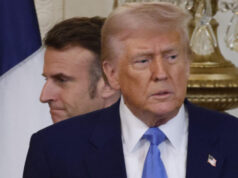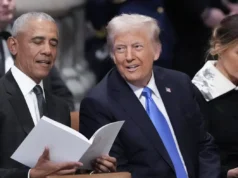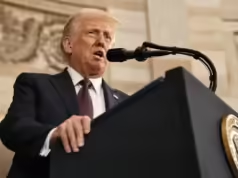On Sunday, the United States and the European Union reached what President Donald Trump called the “biggest-ever” agreement to end a transatlantic tariff dispute that was on the verge of degenerating into a full-scale trade war. Following a high-stakes meeting at his golf estate in Scotland with European Commission President Ursula von der Leyen, Trump declared that EU exports to the US would be subject to a baseline tariff of 15%.
The leaders reached the agreement in about an hour, with a deadline of August 1st looming to prevent a 30 percent US charge on all European exports.
“An agreement has been reached. For all, it’s a good deal. “This is likely the largest agreement ever made in any capacity,” Trump declared.
Trump said that the 15 percent levy will be applied to all industries, including semiconductors, medicines, and Europe’s vital car industry.
Trump said that as part of the agreement, the 27-nation EU group had committed to investing an additional $600 billion and buying “$750 billion worth of energy” from the US.
As part of the bloc’s effort to diversify away from Russian supplies, von der Leyen stated that the “significant” purchases of US oil, nuclear fuels, and liquefied natural gas would be spread out over three years.
Von der Leyen had been working hard to rescue a trade partnership worth $1.9 trillion in products and services annually while negotiating on behalf of the EU’s 27 member states.
According to the EU chief, “It’s a good deal,” reporters said.
“Stability will result. Predictability will result. For our companies on both sides of the Atlantic, that is crucial,” she stated.
According to her, bilateral tariff exclusions have been agreed upon for a number of “strategic products,” including essential raw minerals, aeroplanes, some chemicals, and some agricultural products.
The EU, according to von der Leyen, is still hoping to reach more so-called “zero-for-zero” accords, particularly for alcohol, which she claimed would be “sorted out” in the days ahead.
Additionally, Trump stated that the European Union, which just promised to increase its defence budget within NATO, will be investing “hundreds of billions of dollars worth of military equipment.”
The best we could get
Since Trump took over the White House, the EU has been subject to many rounds of tariffs.
Currently, it faces a 25 percent vehicle tax, a 50 percent steel and aluminium tax, and a 10 percent general tariff, which Washington threatens to increase to 30 percent in the event of a no-deal.
The auto industry, which is vital to France and Germany, is already suffering from the tariffs that have been applied thus far. The bloc has been adamantly advocating for tariff carve-outs for vital industries ranging from spirits to aeroplanes.
Von der Leyen admitted, “Fifteen percent is the best we could get, but it shouldn’t be underestimated.”
Any agreement must be accepted by EU member states, whose ambassadors the commission updated Sunday morning while they were in Greenland. Following the agreement reached in Scotland, they were scheduled to meet once more.
The agreement was swiftly praised by German Chancellor Friedrich Merz, who said that it prevented “needless escalation in transatlantic trade relations”.
German exporters, meanwhile, were less excited. The nation’s VCI chemical trade association claimed that the pact left rates “too high,” while the influential BDI federation of industrial groups stated that it would have “considerable negative repercussions.”
In order to avoid tariffs, the EU had pressed for a steel agreement that would let a specific quota to enter the US.
The EU chief then reiterated that “tariffs will be cut and a quota system will be put in place” for steel, despite Trump’s subsequent statements that steel was “staying the way it is” and seemingly ruling that out.
The large one
The current situation is mirrored by the 15 percent tax, which is a flat rate of 10 percent, even though it is significantly higher than the pre-existing US tariffs on European goods, which average about 4.8 percent.
In the event that the negotiations broke down, EU nations approved counter-tariffs on $109 billion (93 billion euros) worth of US goods, including automobiles and aeroplanes, which would go into effect gradually starting on August 7.
Trump has started a campaign to change how the United States trades with other nations, and he has threatened to impose punishing tariffs on dozens of them if they do not come to an agreement with Washington by August 1.
“This was the big one,” Trump said when asked what the next agreement will be. The largest of them all is this one.







